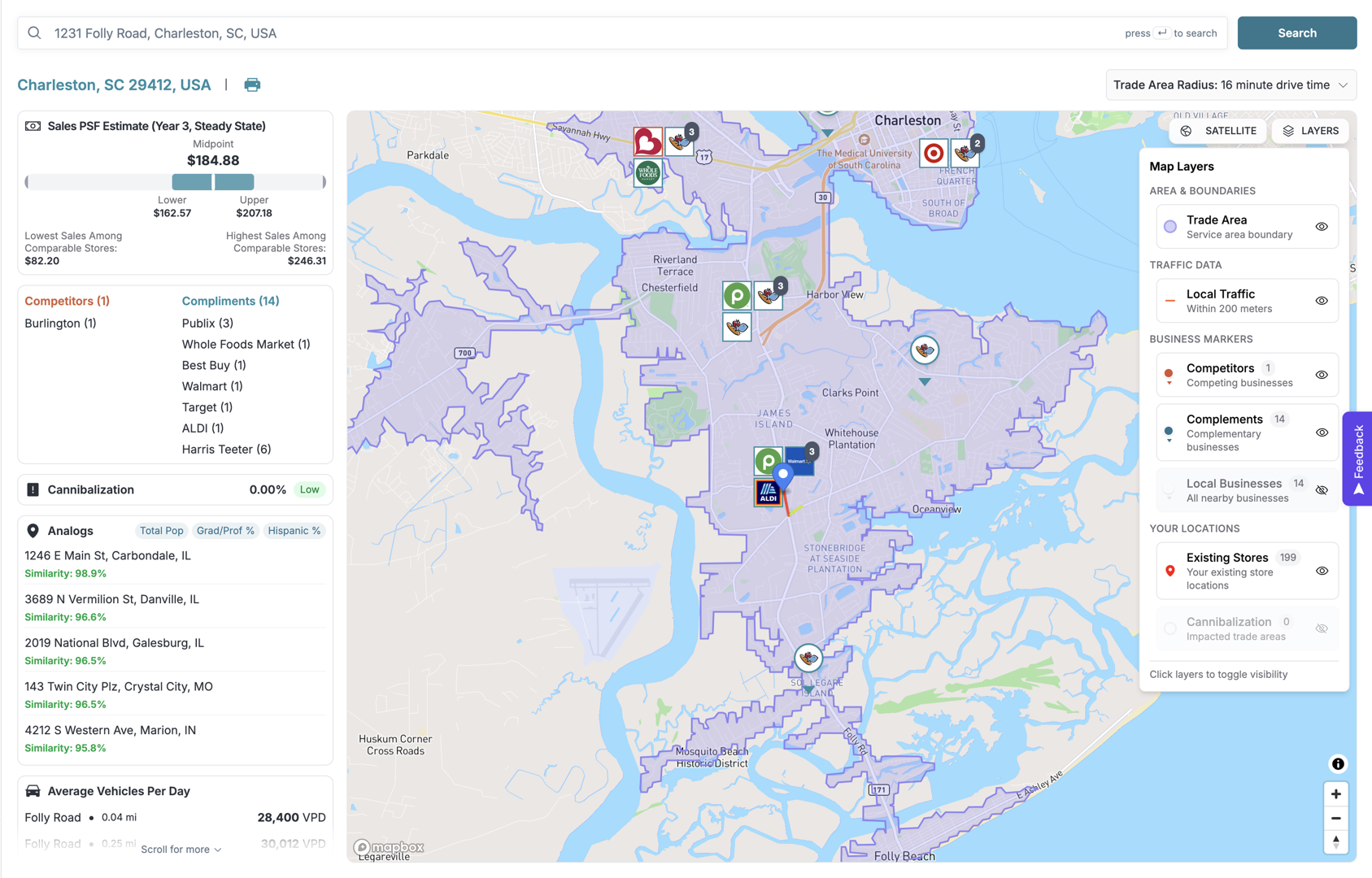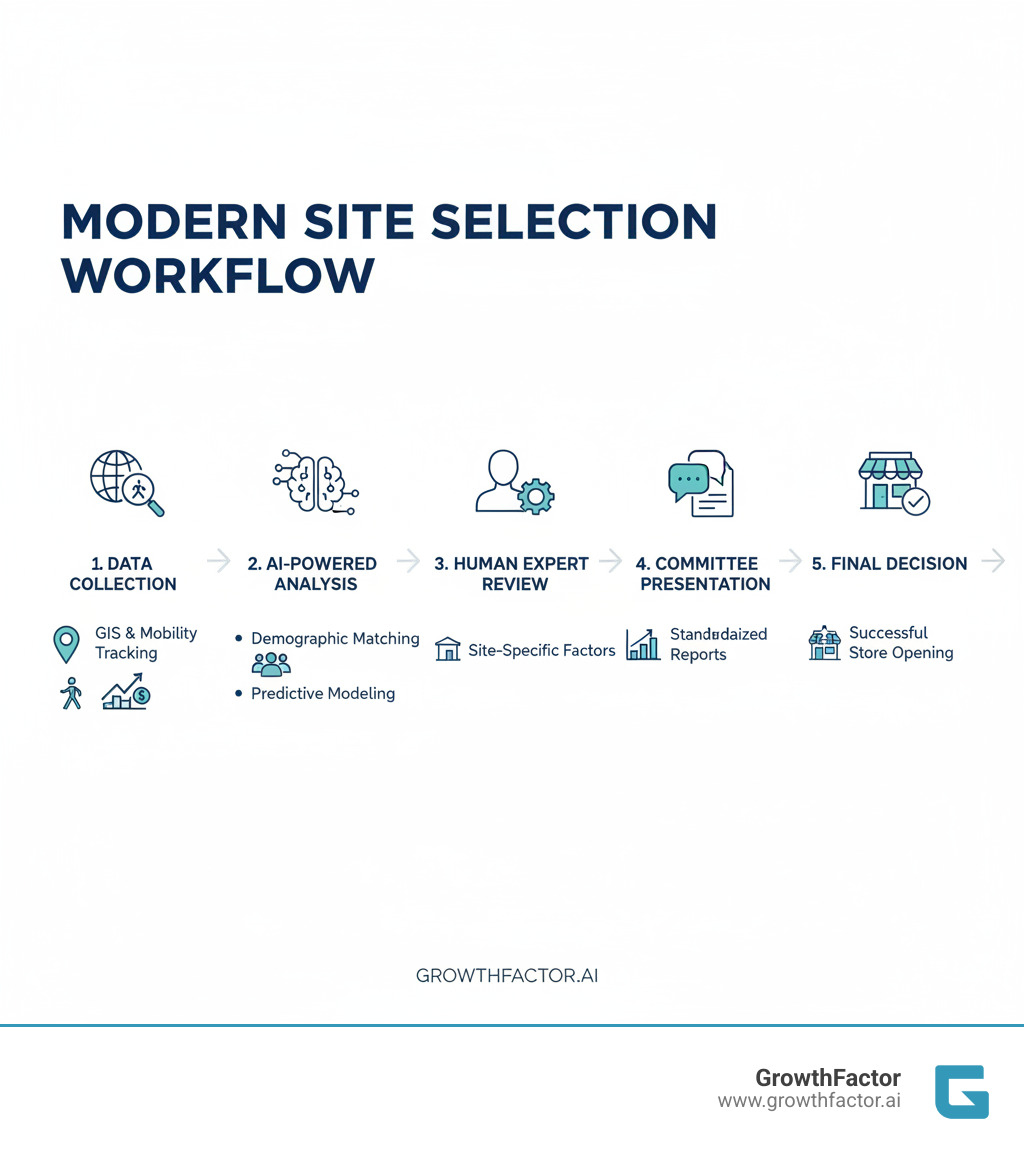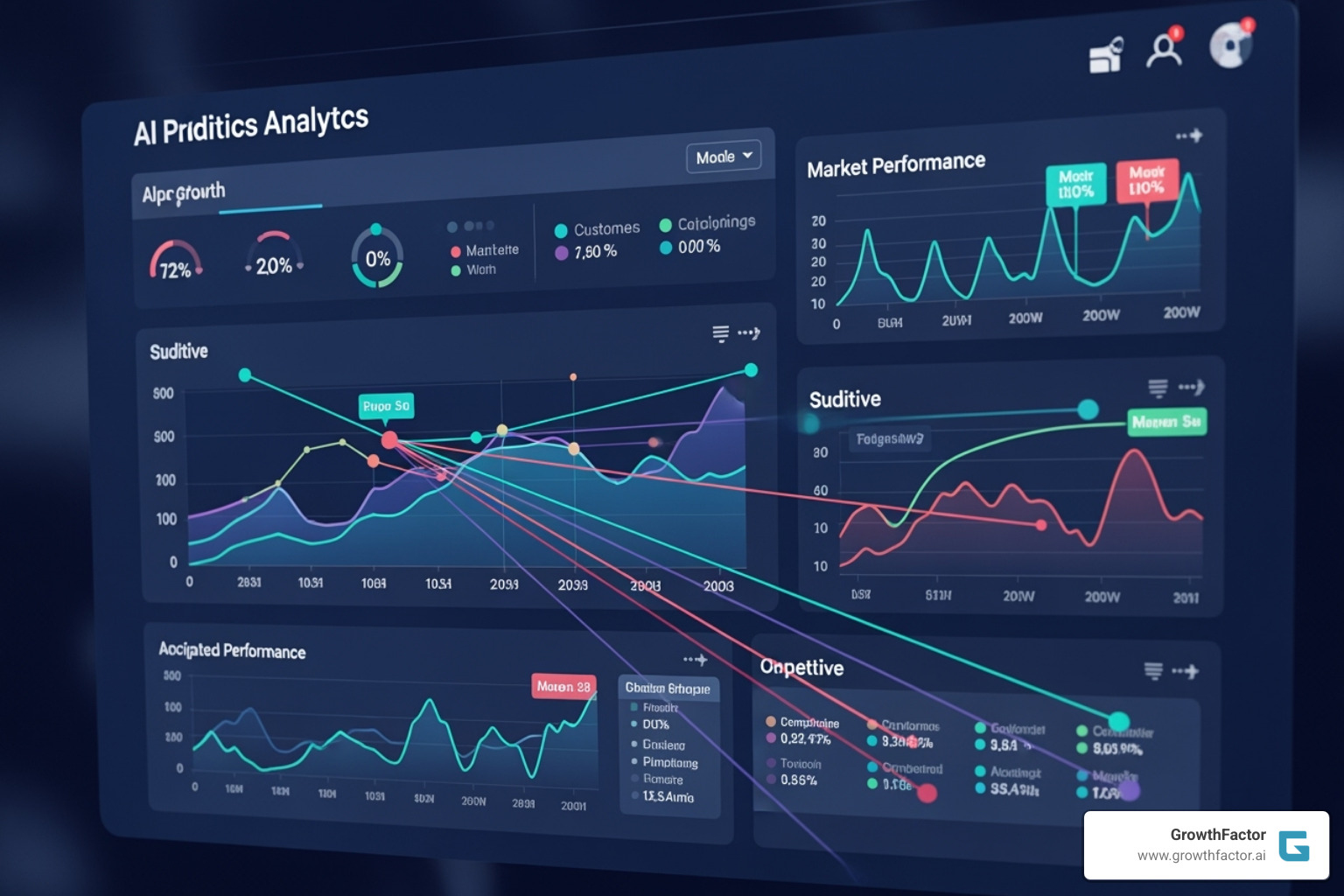Your Tech Toolkit: Essential Site Selection Technologies for 2025
Why Site Selection Technology Matters More Than Ever

Site selection technology is revolutionizing how retail chains choose new locations. By combining geographic data, predictive analytics, and AI, modern platforms analyze demographics, foot traffic, and market trends in minutes, replacing months of manual research with data-driven confidence.
Key Components of Site Selection Technology:
- Geographic Information Systems (GIS) - Visual mapping and spatial analysis of trade areas
- Location Intelligence Platforms - Real-time demographic and mobility data integration
- Predictive Analytics - Revenue forecasting and cannibalization risk assessment
- AI-Powered Tools - Automated site scoring and market opportunity identification
- Competitive Analysis - Consumer behavior and whitespace finding
The stakes for location decisions are immense. A single wrong choice can cost millions in lost revenue and wasted expenses. As one retail executive noted, "Location Intelligence is critical to avoid million-dollar mistakes in site selection."
Yet many chains still use outdated methods like spreadsheets and gut instinct, relying on census data that's years behind today's fast-changing consumer behavior. The old playbook is obsolete.
The good news is that site selection is now a data-driven discipline. Modern platforms evaluate thousands of locations in hours, predict revenue with high accuracy, and identify hidden opportunities competitors miss.
This shift delivers precision, not just speed. Technology eliminates guesswork, reduces risk, and enables faster scaling without a proportionally larger real estate team.
However, technology alone isn't enough. The most successful retailers blend cutting-edge tools with strategic human judgment—the crucial balance between "science and art."
I'm Clyde Christian Anderson, Founder and CEO of GrowthFactor.ai. With over a decade in retail real estate, I've seen every side of the business. At GrowthFactor, we've helped clients open 550+ new locations with a 99.8% success rate by combining advanced site selection technology with fractional human expertise.

Simple guide to site selection technology:
The Evolution of Site Selection: From Gut Instinct to Geospatial Data
For decades, choosing a new store location was more art than science. Decisions were based on driving around neighborhoods, using paper maps, outdated census reports, and the intangible quality of gut instinct.
While experienced operators developed a feel for promising locations, this traditional approach had serious limitations. Manual research took months, the data was often years out of date, and personal observations were inherently subjective.
The real danger was human error and bias. A fondness for a location could overshadow mismatched demographics, or an outdated perception could cause you to miss a revitalized neighborhood. These blind spots led to costly, long-term mistakes.
The financial stakes were brutal. A single poor location decision meant millions in lost revenue and wasted costs, and some retailers never recovered from expansions based on intuition.
Then, site selection technology transformed the process. What took weeks of research can now be analyzed in hours with greater accuracy. Modern platforms integrate real-time data sources like mobility patterns, consumer spending, and demographic shifts—data traditional methods could never access.
This shift replaces uncertainty with confidence and guesswork with evidence. Today's tech combines powerful geographic information systems with predictive analytics to reveal opportunities and risks invisible to traditional methods.
| Feature | Traditional Site Selection | Tech-Driven Site Selection |
|---|---|---|
| Speed | Weeks to months of manual research | Hours to days for comprehensive analysis |
| Accuracy | Subjective, prone to human error and bias | Data-driven, objective, and highly precise |
| Data Sources | Outdated census data, personal observations | Real-time demographics, mobility data, psychographics |
| ROI | High risk of costly mistakes, uncertain returns | Reduced risk, optimized performance, maximized returns |
The beauty of this evolution is that you aren't abandoning valuable market knowledge. Instead, you're giving experienced professionals better tools to apply their expertise. The science of data improves the art of site selection—it doesn't replace it.
This technology-driven approach has become essential for smart growth. When you can analyze thousands of potential sites simultaneously, predict revenue accurately, and identify hidden risks before signing a lease, you operate at a different level than competitors still relying on intuition. For a deeper dive into how data transforms this process, explore our guide on Data-Driven Site Selection.
The change from gut instinct to geospatial intelligence isn't just about avoiding mistakes—it's about confidently scaling your retail footprint faster and more profitably than ever before.
Core Components of Modern Site Selection Technology
Modern site selection technology is a powerful toolkit that transforms raw data into strategic insights for business growth.
The foundation is location intelligence: the process of extracting insights from geospatial data to answer critical business questions and avoid costly mistakes. Data integration platforms weave information from dozens of sources—from demographics to foot traffic—into a coherent, comprehensive view of any potential location. This ensures decisions are based on a complete market understanding, not isolated data points.
This is where predictive modeling becomes a game-changer. Instead of just monitoring current stores, analytical models forecast your next big opportunity. This shift from monitoring to predicting separates modern technology from outdated spreadsheets, directly informing your Retail Store Expansion Strategy and turning data into action.
Geographic Information Systems (GIS): The Visual Foundation
Geographic Information Systems (GIS) are the visual backbone of site selection, making complex data understandable at a glance. A GIS map can display countless layers of information simultaneously, from population density to competitor locations and zoning regulations.
This spatial analysis is transformative. By layering datasets onto Trade area maps, you can create visual stories about a location's viability. For example, you can layer environmental risks like flood zones or infrastructure data like soil types to assess building suitability.
GIS handles complexity by visualizing everything from land shape to proximity to supply chains and customer bases on a single property. It provides X-ray vision for real estate decisions. This visual approach makes smarter decisions faster, as spatial patterns emerge that would be invisible in a spreadsheet. For a deeper understanding, explore our guide on Geographic Information System.
The Data That Fuels Decisions: Demographics, Mobility, and More
An uncomfortable truth is that many businesses rely on dangerously outdated data. The U.S. census occurs once a decade, with data released years later. In today's market, that's like navigating with an old map—you're bound to make wrong turns. Consumer behavior shifts constantly, and companies depending on old census data are flying blind. For background on the decennial census process and release schedules, see the U.S. Census Bureau's Decennial Census overview.
Modern site selection technology uses dynamic, real-time data. Demographics now include growth trends, income levels, and age distribution, building a complete picture of potential customers. Our approach to Site Demographics ensures a comprehensive analysis.
Mobility data has revolutionized location analysis by tracking travel patterns, defining trade areas, and revealing real-time foot traffic. While powerful, it has limitations and can skew analysis if used alone. That's why we blend it with other sources for a complete picture. Learn more in our guide to Foot traffic analysis.
Finally, psychographics and consumer spending patterns provide deeper insights than basic demographics. Understanding how customers live, what they value, and their spending habits informs site selection, merchandising, and marketing.
The landscape of spatial analysis is constantly evolving, with new data sources and methodologies emerging regularly.
Predictive Analytics: From Monitoring to Forecasting
The true power of modern site selection technology lies in predicting future opportunities. This shift from reactive monitoring to proactive forecasting is the key to a great expansion strategy.
Whitespace analysis moves beyond instinct to identify your next big opportunity. It pinpoints areas with high customer demand and low supply, allowing you to expand without cannibalizing existing sales.
Modern predictive models go beyond simple sales maps. By combining internal data with external streams like foot traffic and transaction data, they enable highly accurate Sales forecasting for retail.
Site scoring models remove the guesswork from prioritization. They evaluate potential locations against key criteria—demographics, competition, accessibility—and assign scores to rank opportunities. This allows you to see expected performance before investing capital, dramatically reducing risk.
This predictive capability is the cornerstone of our AI-Driven Analytics approach, giving decision-makers the insights they need to make confident, data-backed choices.
The AI Revolution: Making Site Selection Smarter and Faster
Artificial Intelligence is fundamentally changing business technology, especially in site selection technology. AI is turning weeks of work into hours.

Evaluating a single location involves a massive volume of data. While a human analyst takes days per site, AI can analyze hundreds in the same timeframe, processing huge datasets to identify patterns invisible to the human eye.
AI's power extends beyond speed. It automates repetitive tasks like data cleaning and initial screening, freeing analysts to focus on high-level strategy. It also improves decision-making by surfacing deep insights and revealing hidden consumer behavior patterns.
The result is faster expansion, fewer mistakes, and the confidence of making decisions based on comprehensive analysis.
How AI is Enhancing Site Selection Technology Today
In modern retail real estate, AI is at work in tangible ways. Automated feasibility analysis handles the initial heavy lifting, quickly screening sites against basic criteria so experts don't waste time on non-viable options.
AI excels at market trend identification, combining diverse data to spot emerging opportunities before they become obvious. It detects subtle shifts in spending, population, or competition that signal market readiness.
For consumer behavior analysis, AI rapidly analyzes demographics, growth trends, and shopping patterns to determine how well a site aligns with your target customer, going beyond basics to understand nuanced behaviors.
AI-powered reporting processes hundreds of data points and scores them against your criteria, generating comprehensive reports that highlight what matters most. Decision-makers get clear, actionable insights instead of drowning in spreadsheets.
This is what we mean by AI Location Intelligence—using technology to make site selection smarter and faster. Our approach leverages AI-Driven Analytics to empower teams, not replace them.
The Human Element: Why AI Isn't a 'Magic Button'
However, for all its power, AI isn't a magic button that replaces human judgment. Anyone who claims it is doesn't understand site selection.
AI has real limitations in the "art" of site selection. It can't see that a steep hill makes a storefront invisible, nor can it sense a neighborhood's emerging energy before the data reflects it.
This is why on-site verification is critical. Experts must visit locations to evaluate factors algorithms miss: traffic flow, neighbor quality, parking access, and the area's overall feel. These boots-on-the-ground insights separate good sites from great ones.
AI also falls short in negotiating terms and incentives. It can't build relationships with landlords or steer complex permit processes. These tasks require human skills like persuasion and creativity.
Finally, there are community and political considerations. Navigating local authorities and building internal consensus are fundamentally human challenges that require strategic thinking and emotional intelligence.
As long as humans run companies, they will be best served by human experts working with advanced technology. The sweet spot is where sophisticated site selection technology meets experienced human judgment. That's the approach we take with our Site Selection Services, blending AI-powered insights with irreplaceable human expertise.
Putting Technology into Practice for Strategic Expansion
This is where technology proves its worth: driving real-world growth. Site selection technology is valuable because it helps businesses open the right stores in the right places, avoiding costly mistakes and accelerating profitable expansion.

Modern technology transforms expansion from a series of educated guesses into a strategic, repeatable system. It allows businesses to confidently enter new markets and build a Market Entry Strategy grounded in reality.
Industries Benefiting from Advanced Site Selection
- Retail and Restaurant Chains are obvious beneficiaries, as location is everything. Technology helps them analyze foot traffic, understand consumer behavior, find the right demographic mix, and predict sales to avoid costly errors. Precision is critical, as shown in our Retail Site Selection Analysis.
- Healthcare Organizations must balance patient accessibility with operational efficiency. Location intelligence helps them analyze population health needs, workforce availability, and payer mix to find optimal sites for clinics and hospitals.
- Financial Services Institutions use these tools to strategically place branches and ATMs. As banking goes digital, each physical location must serve a specific purpose, from capturing high-value customers to serving underbanked communities.
- Real Estate Investors and Developers use location intelligence to identify properties with high potential returns by analyzing market trends, property values, and future growth indicators.
- Logistics and Distribution Companies need proximity to transportation networks and access to skilled labor. Technology helps them evaluate these factors, along with utility costs and infrastructure, to optimize the supply chain.
The common thread is that location decisions are too important to leave to instinct alone.
How to Choose the Right Site Selection Technology
Choosing the right platform is critical. The key is to understand your specific needs, not just what sounds impressive in a sales pitch.
- Assess your specific business needs. A regional chain's needs differ from a national enterprise's. Your industry, expansion pace, and team capabilities all matter. This is why GrowthFactor offers flexible plans (Core, Growth, and Enterprise) to provide the right level of support.
- Data accuracy and freshness are non-negotiable. Question vendors on data sources and update frequency. Insist on real-time mobility data and current demographic trends over outdated census information.
- Integration capabilities are crucial. Ensure the platform works with your existing CRM, ERP, and BI systems to avoid data silos and improve your workflow.
- Consider scalability. Choose a platform that can handle your future growth in complexity and user numbers. Technology that can't grow with you is a liability.
- The user interface matters. Sophisticated analytics are useless if they aren't accessible. Look for intuitive design and clear visualizations so your team can focus on insights, not software.
- Vendor support and expertise. GrowthFactor is different; we provide both software and dedicated real estate analyst services. You get cutting-edge technology plus strategic guidance from experienced humans.
For a broader look at navigating the technology landscape, explore our guide on Real Estate Technology Solutions.
The Future Outlook: What's Next for Site Selection?
The evolution of site selection technology is accelerating. The tools emerging today will soon make current platforms seem as outdated as paper maps.
Greater precision and hyper-personalization are on the horizon. Soon, algorithms will identify the perfect location for a specific business model, predicting which intersection will resonate with a unique brand based on psychographics and online behavior.
Virtual Reality (VR) and Augmented Reality (AR) are becoming essential tools. Soon, you'll conduct detailed virtual site visits, examining sight lines and visualizing store designs from your office. This will streamline initial screening, saving time and travel costs, though it won't fully replace on-site verification.
Deeper AI and machine learning integration will enable truly predictive systems. These models will forecast performance five or ten years out, accounting for shifting neighborhoods and economic conditions, and helping identify which sites are resilient long-term investments.
Predictive modeling for environmental risk is becoming essential. Future technology will assess flood, heat, and fire risks as standard features. This is about protecting your investment from long-term climate liability, a key part of building a Future-Proof Real Estate strategy.
For global expansion, technology is breaking down barriers. Advanced platforms are learning to steer different regulatory environments and cultural nuances, translating complex international data into actionable insights for mid-sized retailers.
The trajectory is clear: site selection will become faster, smarter, and more precise. But what won't change is the need for human judgment. The future isn't about technology replacing people; it's about technology empowering people to make better decisions with greater confidence.
Conclusion: Build Your Growth Strategy with Confidence
Site selection technology has evolved from notepads to analyzing millions of data points in minutes. We've seen how GIS, real-time mobility data, and predictive analytics provide clarity and foresight before you commit millions to a new location.
AI has accelerated this evolution, but the core truth remains: technology is a powerful tool, not a replacement for human judgment. The most successful expansions blend sophisticated technology with experienced strategic thinking.
AI can score a site based on data, but it can't tell you about a difficult zoning board, a motivated landlord, or poor visibility due to landscaping. These crucial insights come only from boots-on-the-ground experience.
This blend of data science and human expertise is what separates good from great site selection, helping chains avoid million-dollar mistakes and turn promising locations into profitable stores.
Industries from retail to healthcare understand that location decisions have long-term consequences. Getting it right ensures years of success; getting it wrong drains resources and morale.
At GrowthFactor, our approach is built on this philosophy. Our AI-improved platform provides the data for quick, informed decisions. But we don't stop there. Our dedicated real estate analyst services provide experienced professionals to interpret that data, validate assumptions, and guide you through market complexities.
We've helped clients open over 550 locations with a 99.8% success rate because we combine cutting-edge site selection technology with real-world expertise. We know every business is different, which is why we offer flexible plans—Core, Growth, and Enterprise—that scale with your ambitions.
The future of site selection is bright, with innovations in VR, deeper AI integration, and sophisticated risk assessment tools. But the fundamental truth remains: the best decisions come from marrying technology with human insight.
Your expansion strategy deserves both. You deserve a partner who provides not just software, but support. Not just data, but direction. Not just tools, but talent.
Ready to build your growth strategy with confidence? Explore our All-in-One Real Estate Platform for Retail and find how we can help you find your next winning location—faster, smarter, and with less risk.
Citations
The human algorithm
Request Your demo
Schedule meeting
Or submit your information below and we'll be in touch to schedule.


